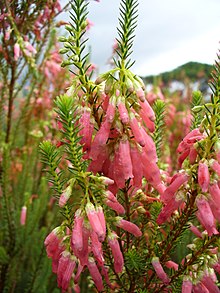
Euphorbia mellifera, the Canary spurge or honey spurge, is a species of flowering plant in the spurge family Euphorbiaceae, native to Madeira and the Canary Islands. It is an evergreen shrub or tree growing to 2.5 m (8.2 ft) tall and broad, with narrow leaves up to 20 cm (8 in) long. In spring it produces brown, honey-scented flowers.

Erica arborea, the tree heath or tree heather, is a species of flowering plant (angiosperms) in the heather family Ericaceae, native to the Mediterranean Basin and Ethiopia, Kenya and Tanzania in East Africa. It is also cultivated as an ornamental.

Pinus parviflora, also known as five-needle pine, or Japanese white pine, is a pine in the white pine group, Pinus subgenus Strobus, native to Japan.

Daboecia, or St. Dabeoc's heath, is a small genus of flowering plants in the family Ericaceae, containing two evergreen shrubs, closely related to the genus Erica. They are native to cliffs and heathland in southern Atlantic Europe and the Azores.

Trollius is a genus of about 30 species of flowering plants closely related to Ranunculus, in the family Ranunculaceae. The common name of some species is globeflower or globe flower. The generic name is derived from the Swiss-German word "Trollblume", meaning a rounded flower. Native to the cool temperate regions of the Northern Hemisphere, with the greatest diversity of species in Asia, Trollius usually grow in heavy, wet clay soils.

Erica vagans, the Cornish heath or wandering heath, is a species of flowering plant in the family Ericaceae, native to Ireland, Cornwall, western France and Spain. It is a vigorous, spreading, evergreen heather reaching 75 cm (30 in) tall and wide, with pink flowers borne in racemes 14 cm (6 in) long in summer and autumn. The Latin specific epithet vagans literally means "wandering"; in this context it means "widely distributed".

Erica cinerea, the bell heather, is a species of flowering plant in the heath family Ericaceae, native to western and central Europe.

Erica carnea, the winter heath, winter-flowering heather, spring heath or alpine heath, is a species of flowering plant in the family Ericaceae, native to mountainous areas of central, eastern and southern Europe, where it grows in coniferous woodlands or stony slopes.

Erica tetralix, the cross-leaved heath, is a species of flowering plant in the family Ericaceae, native to western Europe.

Darmera peltata, the Indian rhubarb or umbrella plant, is a flowering plant, the only species within the genus Darmera in the family Saxifragaceae. It is a slowly spreading rhizomatous perennial native to mountain streamsides in woodland in the western United States, growing to 2 m tall by 1 m wide. The name Darmera honours Karl Darmer, a 19th-century German horticulturist.

Genista tinctoria, the dyer's greenweed or dyer's broom, is a species of flowering plant in the family Fabaceae. Its other common names include dyer's whin, waxen woad and waxen wood. The Latin specific epithet tinctoria means "used as a dye".

Erica lusitanica is a European species of flowering plant in the family Ericaceae, known by the common names Portuguese heath and Spanish heath.
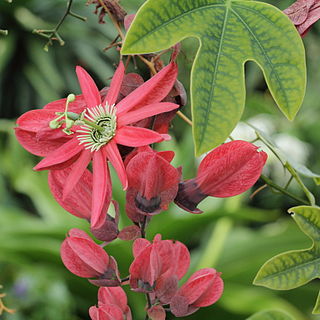
Passiflora racemosa, the red passion flower, is a species of flowering plant in the family Passifloraceae, native to Brazil. It is an evergreen climber growing to 5 m (16 ft), with simple or 3-lobed leaves to 10 cm (4 in) long, and vivid red flowers borne in summer. The flowers are 12 cm (5 in) in diameter, with purple and white coronas. They are followed by oblong green fruits.
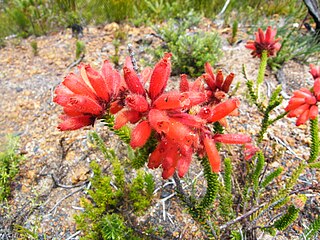
Erica cerinthoides is a species of heath native to South Africa, Lesotho and Eswatini. Common names include fire erica, fire heath, red hairy heath, rooihaartjie or klipheide. Throughout its range the species shows marked variation in habit, flower characteristics and hairiness. A form with white flowers is found in Eswatini and the South African province of Mpumalanga while the variety E. cerinthoides var. barbertona has shorter flowers.
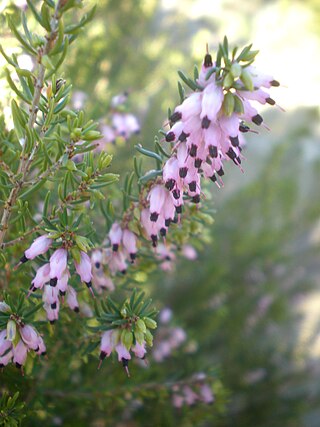
Erica erigena, the Irish heath, is a European species of flowering plant in the family Ericaceae.
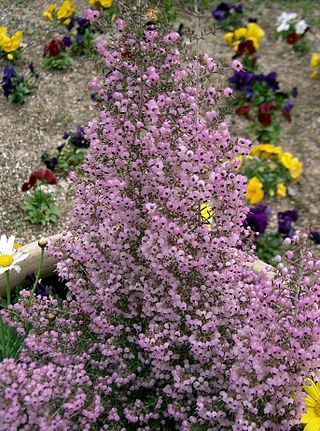
Erica canaliculata, the channelled heath or hairy grey heather, is a South African species of flowering plant in the family Ericaceae.

Ceratostigma willmottianum, Chinese plumbago, is a species of flowering plant in the family Plumbaginaceae that is native to western China and Tibet. It is an ornamental deciduous shrub that grows to 1 metre in height, with pale blue plumbago-like flowers appearing in autumn as the leaves start to turn red.

Thymus pulegioides, common names broad-leaved thyme or lemon thyme, is a species of flowering plant in the family Lamiaceae, native to Europe. Growing to 5–25 cm (2–10 in) tall by 25 cm (10 in) wide, it is a small spreading subshrub with strongly aromatic leaves, and lilac pink flowers in early summer. The specific epithet pulegioides highlights its similarity to another species within Lamiaceae, Mentha pulegium (pennyroyal).

Erica australis, the Spanish heath or Spanish tree heath, is a European species of flowering plant in the family Ericaceae.
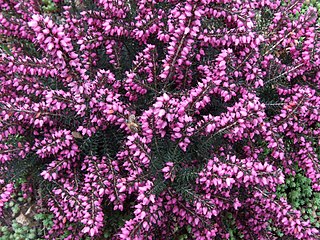
Erica × darleyensis, is a plant hybrid between the heathers E. carnea and E. erigena, probably of garden origin.
